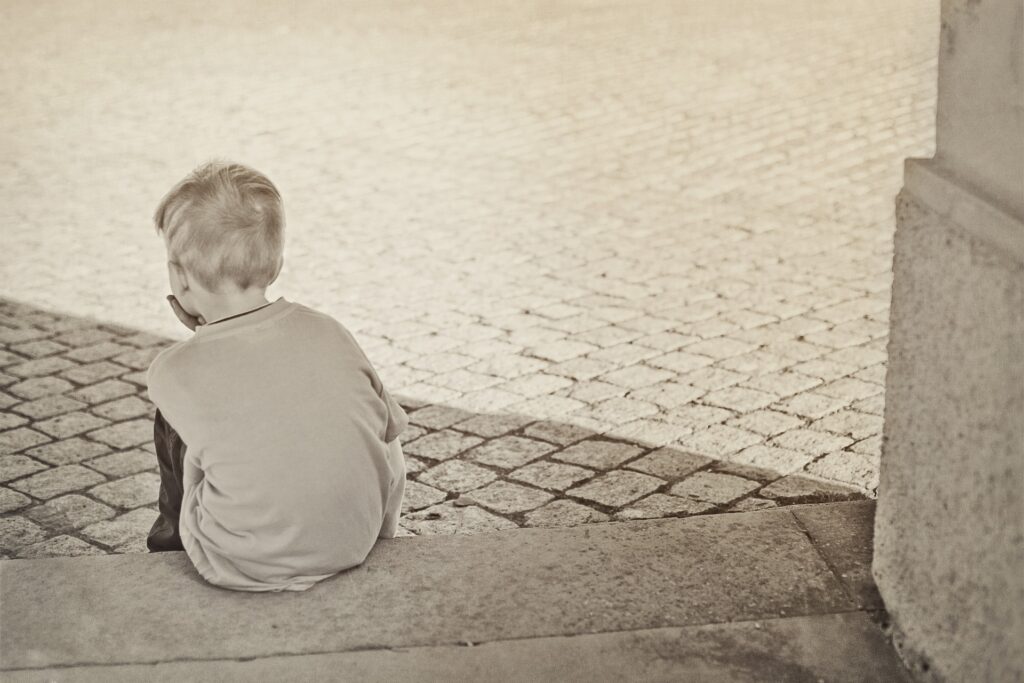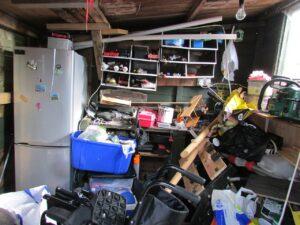Guest blog post by Codie Surratt, MA, LPC, LMT
I started writing this blog post before Covid19 hit as a simple guide to help your child through some of their anxious moments. Now it seems more pressing than ever that parents have a guide to refer to with exercises for your anxious child.
Signs of Anxiety in a Child
We are all feeling turbulent waves of emotions lately. However, our children may be showing signs of their emotions in different ways than we are used to seeing. Your child may be acting out in ways they don’t usually, may seem more volatile, or may be emotionally distancing themselves. 
Maybe they’re exhibiting signs of extreme irritability, sleeplessness, clinging, or reverting to infantile behavior you thought they’d stopped long ago. They may get triggered more quickly than usual, or be preoccupied with death, illness, or emergency services. They could become more focused with the news, exhibiting a heightened awareness of medical or political speech.
Perhaps you notice darker themes within their play. As Virginia Axline points out in her groundbreaking book, Play Therapy, playing is the medium of self-expression for children. Games and play are where they display evidence of what their minds are trying to reconcile. You may notice more aggressive play themes centered on caregiving and healthcare or emergency services like police and firefighters. Maybe your child’s play is focused on the duality of good versus evil. You might notice themes centered on family, school, friends, and social functions.
Related Reading: Why Knowing These Common Signs of Anxiety in Teens Will Make You a Better Parent
The good news is you need not do a thing in terms of their play. If you allow them to fully play out these themes, with several hours of non-directed, creative play each week, they will come to understand their new world. Children are masters of working things out emotionally by playing, so take a break for yourself and let them play, play, play!
How Does Anxiety Affect Brain Development?
The changes in play you may notice are incredibly healthy, given the current atmosphere in which we collectively find ourselves. It’s essential to see how your child may be displaying anxiety or stress. Help them by normalizing all emotions and allowing them to understand better the behaviors they may be presenting.
Learn more about teaching your child to cope with anxiety here!
In Dr. Dan Siegel’s book, Whole-Brain Child, he references what happens in your child’s brain when they are experiencing high stress and emotional dysregulation. It’s quite akin to what occurs in adult and adolescent brains. However, it presents differently in children because they are less resourceful in making sense of what’s happening.
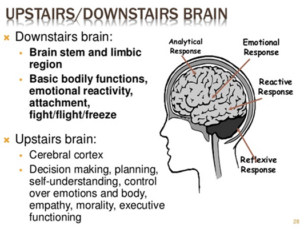 That’s where a helpful, attuned adult can start to change the way anxiety shows up for them. One exercise for your anxious child is to help them “name it to tame it,” as Dr. Siegel says. The nervous system of your anxious child may be on high alert, perceiving threats everywhere. When this happens, the upstairs brain (our prefrontal cortex) and the downstairs brain (our limbic system) are out of sync.
That’s where a helpful, attuned adult can start to change the way anxiety shows up for them. One exercise for your anxious child is to help them “name it to tame it,” as Dr. Siegel says. The nervous system of your anxious child may be on high alert, perceiving threats everywhere. When this happens, the upstairs brain (our prefrontal cortex) and the downstairs brain (our limbic system) are out of sync.
You might imagine an upstairs and a downstairs connected by a staircase, and that staircase has toppled over. When this happens, we are functioning from our most primal senses. This heightened emotional state is easily triggered, so you might see in your child a sense of vigilance, needing to be in control of their surroundings, and ready to fight/flight/freeze at a moment’s notice.
As Dr. Siegel points out, in that situation we have “flipped our lid.” In that primal state, we cannot be reasoned with. Instead, we must feel seen, soothed, and safe to get our staircase back up and our top and bottom brains working together once again.
The 3 R’s Method
Dr. Bruce Perry, the author of The Boy Who Was Raised As a Dog, developed the 3 R’s method for helping children to regulate challenging emotions. This exercise for your anxious child is an excellent tool to get your child top and bottom brains back online and in sync.
1). Regulate:
Simply be there for the child, holding them if they need to be held and using a gentle, soft, and soothing voice to help co-regulate their nervous system. Touch can be valuable in this stage; however, it needs to feel safe for your child at that moment. Make sure it’s ok if you put your hand on their leg, hand, or body if they’d like a hug.
In this regulation phase, you aren’t problem-solving in any way. You are simply with your child in their time of need. Breathing slowly and diaphragmatically in this phase is extremely important, and modeling this to them during this time can be very effective.
2). Relate:
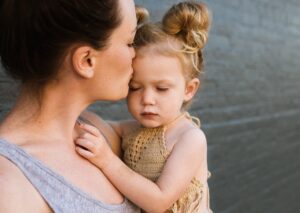 This the “seen” phase. Your child need to feel seen. Using phrases like the following can help: I see that this is hard for you, I see that you are hurting, I understand that this feels bad, I know that you are trying and it’s just not working out, it isn’t easy, this is sad, this is scary, this isn’t fair.
This the “seen” phase. Your child need to feel seen. Using phrases like the following can help: I see that this is hard for you, I see that you are hurting, I understand that this feels bad, I know that you are trying and it’s just not working out, it isn’t easy, this is sad, this is scary, this isn’t fair.
During this phase, you want to not only help your child regulate and apply language to their emotions, but also to know that you understand, see them, feel what they are going through, and will be there for them no matter what.
3). Reason:
This is the safe phase, which helps them understand that they aren’t bad; they simply have strong emotions and have acted upon those emotions in a way that might be hurtful. This phase is ONLY APPLICABLE when their “staircase” is back up, and their top and bottom brains are working together again.
Now you can start to address behaviors that may not be acceptable, “I know you didn’t mean to hit your sister earlier when you were upset, but can you see how that might make her feel sad?” “I know you were angry when you yelled at Mama earlier, can we talk about what you said?” “I understand that you are hurting and you slammed the door and broke the picture, I know that wasn’t your intention, can you think of a better way you could have handled your anger?”
It’s Ok. This is Hard.
So, before we move onto the five mindfulness exercises for your anxious child, I’d like to start by saying you are doing a fantastic job. The fact that you are were drawn to this post is evidence of that – you want to help your child.
Parenting is challenging on a good day, and these are tough days, folks! You might notice your own staircase falling and your lid getting flipped more often than not. It’s ok.
I see you. I see how hard you are trying to hold things together and I honor that. This blog is a reference when you’re ready that may help when things get really hard for your child. But make no mistake, this stuff takes patience, it takes practice, and not one parent out there gets it right all the time.
It’s like I always say, the more you do it, the less you’ll have to, but beating yourself up for not being the perfect parent and getting it right all the time is of no help to you or your children, so just know you are doing a fantastic job.
Want more family friendly ideas for anxiety? Check out our article on yoga family therapy!
5 Mindfulness Exercises for Your Anxious Child
Now, here are five simple mindfulness activities to do with your child that can help regulate their emotions, calm their nervous systems, and help them feel less out of control.
1). 5 Senses Walk
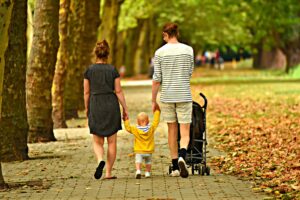 I know most of us are doing our fair share of walking lately to offset not being at the gym, pool, or other exercise venue. Here are some tips to help make those walks more mindful: Tap into their five senses while on your daily walks; notice what you see, hear, smell, taste and feel. Maybe you see some birds, smell a fire burning in a fireplace, feel a flower, notice the air tastes sweet, and hear laughter. Take your time, and throughout the walk, check-in with your five senses and those of your child.
I know most of us are doing our fair share of walking lately to offset not being at the gym, pool, or other exercise venue. Here are some tips to help make those walks more mindful: Tap into their five senses while on your daily walks; notice what you see, hear, smell, taste and feel. Maybe you see some birds, smell a fire burning in a fireplace, feel a flower, notice the air tastes sweet, and hear laughter. Take your time, and throughout the walk, check-in with your five senses and those of your child.
2). Balance a quarter
This is another fun walk-inspired activity. Have your child take off their shoes and socks and place a quarter on top of one of their feet. Then have them walk in a straight line from a starting point to and ending point on which you agree. It’s tougher than it sounds, and it forces a very slow, careful walk, which inspires deep present moment awareness. It’s fun for adults to try too, and that can be fun for the kids to see.
3) Mandala Coloring
Creating art is a mindful process, but there is something transfixing about a mandala. The form is so simple, and there are no rules. The grass doesn’t have to be green, the house isn’t brown, and there are no characters, simply lines forming a pattern. Mandalas have long been an excellent form of mindful activity and can be quickly acquired through mandala-coloring books, or even on Pinterest.
Related reading: How to Manage Fear and Anxiety during Coronavirus Pandemic
4). Mindful Eating
This can be really fun, however, it is the ultimate practice in patience and slowing way down. When you mindfully eat something, you aren’t merely noticing the redness of the apple or the tartness of a cherry; you are holding that item in your hand and seeing everything you can about it. You are noticing the texture, the smell, and the long and winding road it took to get to your home.
This activity can take up to 30 minutes or more if you truly sit with the item and notice it. Mindful eating is fun for kids because their little reward at the end is getting to eat the food, and it’s a great practice of not only slowing down but becoming hyper-aware of where our food comes from. Win-win!
5). Bubble Blowing
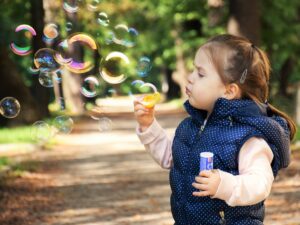 This is my go-to practice for deep breathing with kids. Everyone loves a good bubble blowing session, but to truly make it mindful, be present and aware of how the bubble floats, how slow you can breathe into the wand, how big you can make the bubble. Talk about what it feels like to blow the breath hard and what it feels like to take a deep belly breath and blow the breath slow. Blowing bubbles is a fun one to do, and it takes relatively no effort.
This is my go-to practice for deep breathing with kids. Everyone loves a good bubble blowing session, but to truly make it mindful, be present and aware of how the bubble floats, how slow you can breathe into the wand, how big you can make the bubble. Talk about what it feels like to blow the breath hard and what it feels like to take a deep belly breath and blow the breath slow. Blowing bubbles is a fun one to do, and it takes relatively no effort.
(Covid caution: if there is any concern that someone in your household may have the virus or be a carrier, exhalations that are more forceful, as in blowing bubbles, should be used with caution! In these cases much more than 6 feet distancing is required. See the CDC’s coronavirus website for guidelines.)
Help with Childhood Anxiety
Anxiety is challenging as an adult, but seeing our kids affected by it can be a real struggle. I hope you find some comfort and an increased sense of parenting effectiveness in these exercises for your anxious child. And I hope you know how grateful I am you chose to read this; it further proves what I said earlier, you’re doing a fantastic job!
 However, if you or your child need some extra support, I specialize in treating anxiety, stress, grief, and trauma in children and adolescents, and I’m am accepting new clients via telehealth sessions. I hope you stay safe, have grace with yourself and your family during these unprecedented times, and all of us at Life Care Wellness are here for any mental health needs you have.
However, if you or your child need some extra support, I specialize in treating anxiety, stress, grief, and trauma in children and adolescents, and I’m am accepting new clients via telehealth sessions. I hope you stay safe, have grace with yourself and your family during these unprecedented times, and all of us at Life Care Wellness are here for any mental health needs you have.
If you feel therapy might help your child and are in the Chicago, Glen Ellyn, or Sycamore Illinois area, please call Life Care Wellness at (630) 423-5935.

